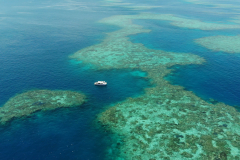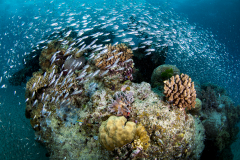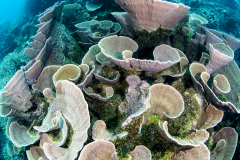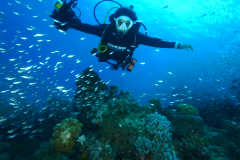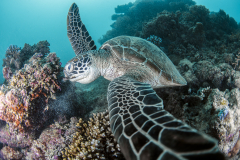The Great Barrier Reef. It’s hard not to use superlatives when talking about the largest living structure on Earth. Astronauts report that they can see the reef from space, stretching in all its aquamarine glory for 1,400 miles (2,300 kilometers) along the northern Queensland coast.
Although often thought of as one structure, the reef actually includes a staggering 3,000 coral reefs, 600 continental islands and 900 coral cays, too many for just one visit to the Great Barrier Reef.
Divers can drop in on the reef all the way from Bundaberg in the south to far northern Queensland on seasonal liveaboards. Popular points of access are the Whitsunday Islands, Townsville, Cairns and Port Douglas. The reef is also accessible by air from Brisbane (Redcliffe), the Gold Coast and Hervey Bay. In most cases, the reef is a few hours offshore, so you’ll need to book a boat tour, either for the day or overnight on a liveaboard. The diving is — as you’d imagine — outstanding. There are 1,625 species of fish on the reef, 133 types of sharks and rays, and 600 types of hard and soft coral. Time your visit with seasonal migrations, and you can snorkel with dwarf minke whales, who pass through tropical northern Queensland every June to September. Because of this incredible diversity, it’s unsurprising that the reef became a UNESCO World Heritage Area in 1981.
When to visit
If you’re diving the southern reaches of the reef from Yeppoon to Bundaberg, expect air temperatures in winter and spring (June to November) to range from 50 to 81 F (10 to 27 C) and from 68 to 82 F (20 to 28 C) from December through May. Water temperatures can range from 66 to 79 F (19 to 26 C) depending on when you dive.
Make it happen
As a diver, planning a visit to the Great Barrier Reef is a must. There are daily flights from the West Coast of the U.S. to both Brisbane and Sydney, from whence you can catch a connecting flight to Cairns, Townsville, Proserpine (Whitsunday Coast), Hamilton Island, Mackay, Rockhampton, Gladstone or Bundaberg. The best place to start for information about visiting the Great Barrier Reef is on the official Queensland tourism site.


